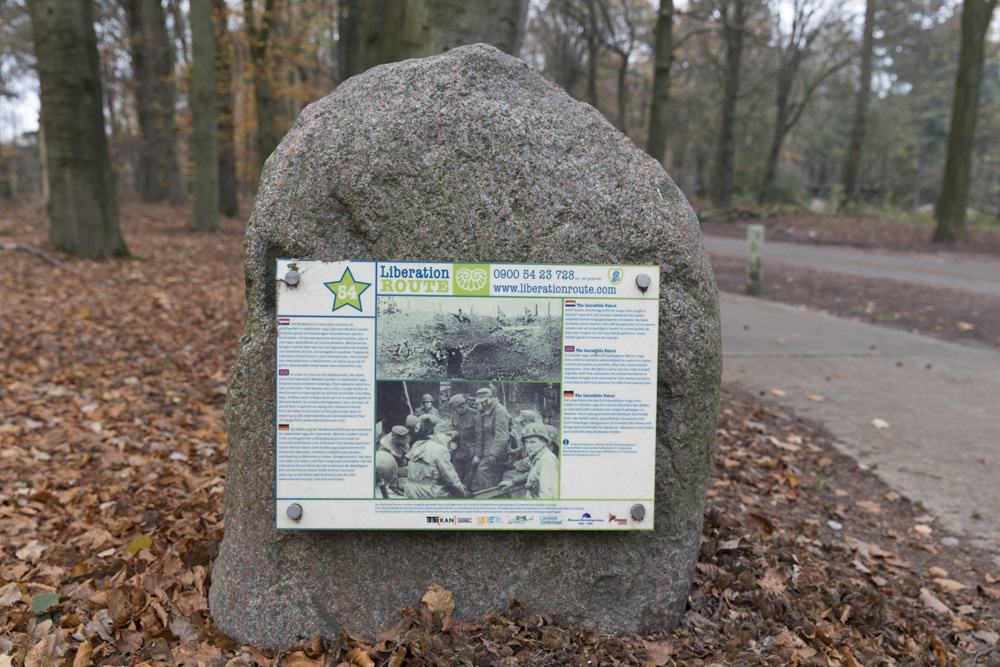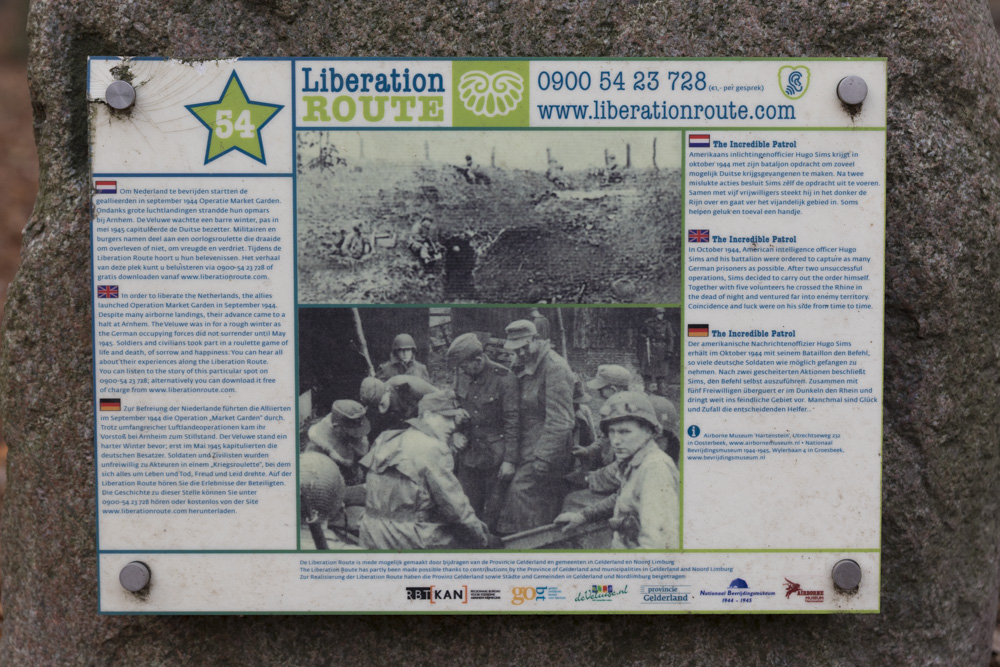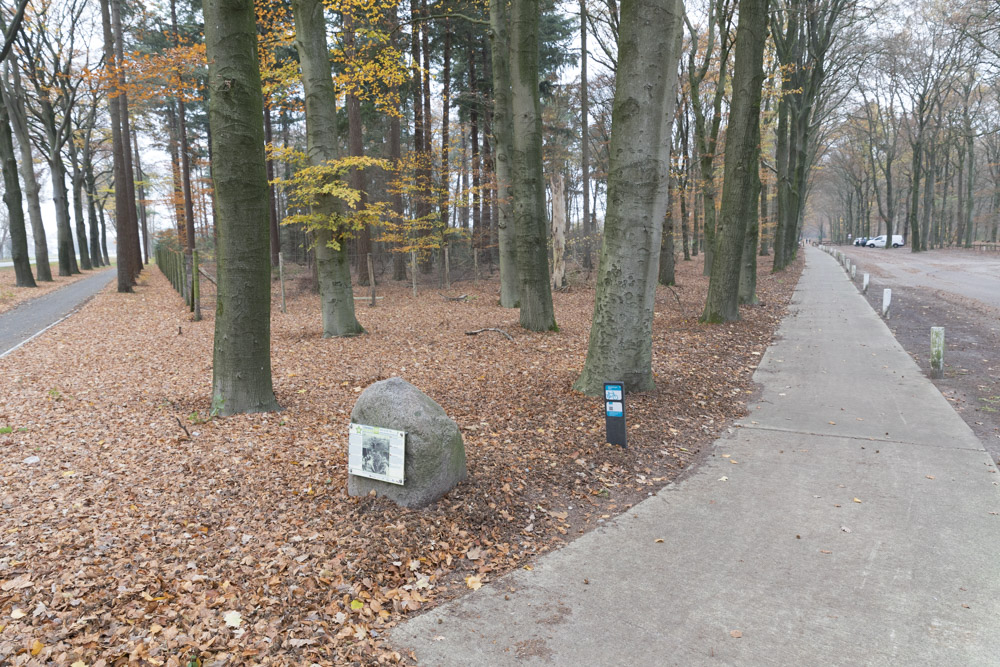Liberation Route Marker 054: The Incredible Patrol
The Incredible Patrol
In October 1944, American intelligence officer Hugo Sims and his battalion were ordered to capture as many German prisoners as possible. After two unsuccessful operations, Sims decided to carry out the order himself. Together with five volunteers he crossed the Rhine in the dead of night and ventured far into enemy territory. Coincidence and luck were on his side from time to time.
In October 1944, the 101st US Airborne Division was positioned in the Betuwe and was trying to find out where the Germans were in the Veluwe. On 30th October six men decided to head towards Ede, crossing the Rhine and arriving at a house on the edge of the Ginkelse Heide (Ginkel Heath) early the following morning. There were two German officers fast asleep in the house so the Americans took them prisoner. Later that morning, they put a number of locals who happened to pass by, under house arrest, shortly before capturing yet another four German soldiers. Then they waited until twilight to start the journey back across the Rhine. The Americans forced one of the German prisoners to stop a German military vehicle as it approached, which he did. There were 13 members of the SS in the back and the Americans took them prisoner too. An SS captain passed by later that evening who surrendered, just like the other 13. Then the men set off in the two vehicles they had just commandeered. Not long after setting off, the vehicles got stuck on the Rijksweg 12 road and the men had to walk to the bank of the Rhine via Renkum. There, they took some guards prisoner and finally crossed the Rhine. By the time they came to reporting to their battalion, they had captured a total of 32 prisoners of war. "Incredible!" was the only response.
Audiospot - The Incredible Patrol
Liberation Route Europe is a certified Cultural Route of the Council of Europe. With hundreds of sites and stories in nine European countries, the route links the main regions along the advance of the Allied Forces in 1943-1945.
The entire route consists of themed routes that can be travelled by by hiking, walking, cycling and car. These routes pass numerous historical and interesting sites and tell stories from a multitude of perspectives that were important in the final phase of World War II.
Many routes feature listening spots, offering the opportunity to listen to a historical story at a location. In addition, many ‘Vectors of Memory’ have been placed, indicating that the passer-by is on one of the Liberation Routes.
The routes can be found on the Liberation Route Europe website or in the app through which many stories can also be listened to.
Do you have more information about this location? Inform us!
Source
- Text: TracesOfWar & Liberation Route Europe
- Photos: Arjan Vrieze
Nearby
Museum
- Exhibition Glider Collection Wolfheze - Wolfheze
- 4.8 km
- War and- Garrison museum 'De Smederij' - Ede
- 5.0 km
- Airborne Museum 'Hartenstein' - Oosterbeek
- 8.0 km
Point of interest
- Information sign 'Incredible Patrol' along the Ede-Arnhem road - Ede
- 0.1 km
- Landmark Ginkel Heath - Ede
- 0.8 km
- Information sign Zuid-Ginkel Inn and the three fallen hussars - Ede
- 0.8 km
Monument
- Memorial Café Zuid Ginkel - Ede
- 0.8 km
- Boulder on the Ginkelse Heide - Ede
- 0.8 km
- Liberation Route Marker 055: Battle of Ginkel Heath - Ede
- 0.9 km
Cemetery
- Dutch War Graves Wolfheze - Wolfheze
- 4.7 km
- Mausoleum Paasberg Ede - Ede
- 4.7 km
- Dutch War Grave Ede - Ede
- 5.6 km
Remembrance Stone
- Stumbling Stones Bosbeekweg 19-21 - Bennekom
- 3.3 km
- Stumbling Stones Prins Bernhardlaan 28 - Bennekom
- 6.0 km
- Stumbling Stones Schoolstraat 38 - Bennekom
- 6.1 km
Fortification
- Foxholes 4th Parachute Brigade Headquarters - Wolfheze
- 6.0 km
- Flak Position Koningsweg Arnhem - Arnhem
- 6.5 km







